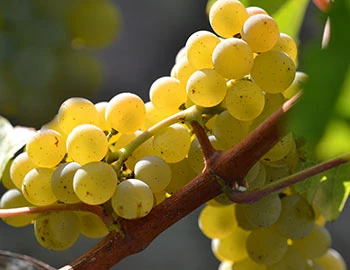Con Vento 2023
IGT Toscana, Tenuta del Terriccio, 750 ml

| Grape variety: | Viognier, Sauvignon Blanc |
| Producer: | Castello del Terriccio |
| Origin: | Italy / Toscana |
| Other vintages: |
Description
The aromatic blend of Sauvignon Blanc and Viognier reveals a characterful and fragrant bouquet, reminiscent of dried apricots, ripe, juicy peaches, yellow exotic fruits as mango. Accompanying floral notes of acacia and freesia, as well as hay flower, white pepper and tarragon. On the palate, the white Tuscan shows itself fresh and invigorating with a fine, salty vein. Delicately tart aromas of grapefruit, lime zest and again bright stone fruit and almonds lines the palate. The name of this cuvée is a wordplay with a double meaning: "convent", stands for monastery in Italian, and "with the wind" on the other hand. The golden yellow ears of wheat, which adorn the label and are very typical of Tuscany, sway in the wind.
Attributes
| Origin: | Italy / Toscana |
| Grape variety: | Viognier, Sauvignon Blanc |
| Label: | Vegan |
| Ripening potential: | 1 to 4 years |
| Drinking temperature: | 10 to 12 °C |
| Food Pairing: | Apéro riche, Fresh water fish with cream sauce, Fish ragout with saffron sauce, Goat's cheese, Vegetable pie, Salad with vegetables, pulses, pasta |
| Vinification: | soft pressing, short must fermentation |
| Harvest: | hand-picking, strict selection |
| Maturation: | bâtonnage, in steel tank |
| Bottling: | no filtration |
| Maturation duration: | 6 months |
| Volume: | 13.0 % |
| Note: | Contains sulphites |
Castello del Terriccio
Castello del Terriccio is one of the largest agricultural estates in Tuscany (Province of Pisa) with its own microclimate. The approximately 1700 hectares extend from the northern end of the Maremma to the Tyrrhenian Sea. The vineyards enjoy a south-southwest exposure with the warming and luminous effect of the sea. The Mediterranean maquis and the eucalyptus trees growing all around it not only protect the grapes from the wind, but also imbue them with the scents and aromas that give the wines of the Terriccio their distinctive flavour.
Leaving the charming Tuscan town of Castellina Marittima via the narrow and picturesque serpentine road passing large pine trees and wonderful scenery, after a few kilometres you reach the gates of the splendid Castello del Terriccio estate. After the entrance, a private road leads up to the vineyard. On the way there, the gently rolling hills of the Maremma pass you by: forests, fields with Limousine cattle and horses, vineyards and of course olive groves. Situated at the top of a hill is the centre of the Castello, with a historic village centre, manor house, granary, wine cellar, olive press, and, of course, the obligatory church. The view of the seemingly infinite landscape and the dark blue Tyrrhenian Sea with the islands of Elba, Capraia, and Corsica is of a breathtaking, rare beauty. Castello del Terriccio is located north of Bolgheri in the Province of Pisa within the Maremma. With its impressive 1700 hectares, including 65 hectares of vineyards, it is one of the largest private estates in Tuscany.

Sauvignon Blanc
The Sauvignon blanc can be recognized with your eyes closed. Its typical bouquet is marked by green notes: freshly cut grass, tomato bunches, gooseberry. Citrus fruits, cassis and flint join into the mix. In warmer latitudes it also shows exotic aromas, such as passion fruit. Its acidity is decidedly lively. In all likelihood, it comes from the Loire Valley, where it is vinified in Pouilly-Fumé and Sancerre in its purest form: varietally, and without timber. In the 18th century, it found its way to Bordeaux. Ambitious producers assemble it there with Sémillon into substantial whites, which are aged in oak barrels. The Sauvignon blanc has been a sensational success in the past 20 years in New Zealand. With its refreshing sweet-and-sour style, winemakers from down under have conquered the world. The rich Sauvignons from Styria and crisp examples of South Tyrol and Friuli are worth mentioning as well. It pairs with anything from the sea. Or do it like they do on the Loire, and enjoy it with goat cheese.

Viognier
Saved from extinction
It’s hard to believe that the Viognier nearly became extinct 50 years ago. Today, it grows worldwide on over 10,000 hectares. The variety was first mentioned in 1781, and probably originated in Condrieu, in the northern Rhône Valley. There, and in the 3.8-hectare mini-appellation of Château-Grillet, vintners kept it on the post when the rest of the world wanted to know nothing about it. Its inventory shrank to a meagre 14 hectares. This is because it provides only low yields, and for a while there were no good seedlings. In the 1980s, interest in Viognier reawakened. It actually shows a unique profile: deep golden with good body and aromas of apricot, lime blossom, citrus fruits, honey and hazelnut. It is popular in the Languedoc region, flows into the white Côtes du Rhône and also does very well in California. The best examples fit wonderfully with poultry in cream sauce, noble fish like turbot or – why not? – lobster.

Italy
Italy – Where wine is a way of life
The Italian wine regions are extremely diverse, and this is made clear in their wines. Established varieties such as Merlot, Syrah, and Sauvignon can be found on just 15 percent of the total vine growing area. The remaining 85 percent is reserved for autochthonous, indigenous varieties. More than 2,000 different grape varieties are grown under diverse conditions and pressed with various techniques into wines that reach the top tier of the international wine market.



